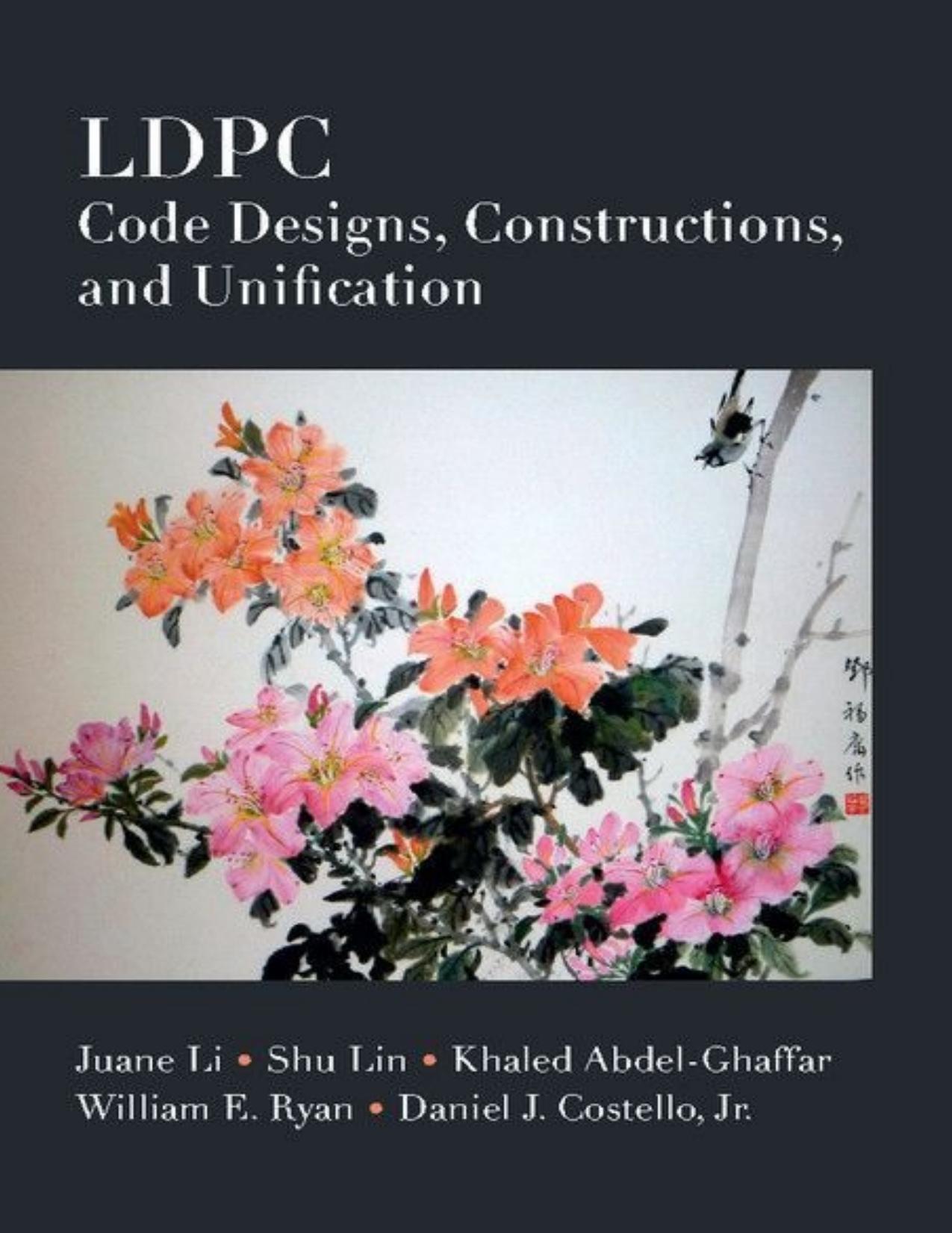LDPC Code Designs, Constructions, and Unification by Juane Li & Shu Lin & Khaled Abdel-Ghaffar & William E. Ryan & Costello Jr Daniel J

Author:Juane Li & Shu Lin & Khaled Abdel-Ghaffar & William E. Ryan & Costello, Jr, Daniel J. [Li, Juane]
Language: eng
Format: azw3, mobi, pdf
Publisher: Cambridge University Press
Published: 2016-11-29T16:00:00+00:00
9.2 Type-1 QC-SC-LDPC Codes
Let Hb,sp,sc(Ï,m,n) be the binary CPM-dispersion of Îq,sp,sc(Ï,m,n). Then, Hb,sp,sc(Ï,m,n) is a semi-infinite array of binary CPMs and ZMs of size (q â 1) Ã (q â 1) with period Ï. It follows from the 2 Ã 2 SM-constrained property of the array Îq,sp,sc(Ï,m,n) that the array Hb,sp,sc(Ï,m,n) satisfies the RC-constraint. The null space of the array Hb,sp,sc(Ï,m,n) gives a periodically time-varying CPM-QC-SC-LDPC code, denoted by Cb,sp,sc(Ï), with period Ï. The Tanner graph, denoted by b,sp,sc(Î), of the CPM-QC-SC-LDPC code Cb,sp,sc(Ï), contains no cycle of length 4 and hence has girth at least 6. It is a periodically time-varying LDPC-C code with constraint length en(q â 1) (in symbols). The CPM-QC-SC-LDPC code Cb,sp,sc(Ï) constructed based on the array Îq,sp,sc(Ï,m,n) is referred to as a type-1 CPM-QC-SC-LDPC code.
For 0 ⤠j < r, let CPM(R0,j) be the binary CPM-dispersion of the mÃn matrix R0,j over GF(q). From the SP-construction point of view, the parity-check matrix Hb,sp,sc(Ï,m,n) of the time-varying CPM-QC-SC-LDPC code Cb,sp,sc(Ï) is constructed by using the set
(9.3)
of m(q â 1) Ãn(q â 1) matrices (mÃn array of CPMs of size (q â 1) Ã (q â 1)) as the replacement set R and the binary matrix Bsp given by (9.4) as the SP-base matrix. Hence, the CPM-QC-SC-LDPC code Cb,sp,sc(Ï) is also a CPM-QC-SP-LDPC code.
From the PTG-construction point of view, the Tanner graph q,sp,sc(Ï,m,n) of the first Ï-span subarray Bq,sp,sc(Ï,m,n) of the array Îq,sp,sc(Ï,m,n) may be regarded as the protograph for the PTG-construction of the CPM-QC-SC-LDPC code Cb,sp,sc(Ï). The edges of q,sp,sc(Ï,m,n) are labeled with nonzero elements in GF(q). In the PTG-based construction of the parity-check matrix Hb,sp,sc(Ï,m,n) of the code Cb,sp,sc(Ï), there are two expansions of the protograph q,sp,sc(Ï,m,n), first expanding q,sp,sc(Ï,m,n) into q,sp,sc(Î) by taking an infinite number of copies of q,sp,sc(Ï,m,n) and connecting them into a chain and then expanding q,sp,sc(Î) by binary CPM-dispersing the q-ary label of each edge in q,sp,sc(Î) to construct the Tanner graph b,sp,sc(Î) of the code Cb,sp,sc(Ï) as described above. The adjacency matrix of b,sp,sc(Î) gives the parity-check matrix Hb,sp,sc(Ï,m,n) of the code Cb,sp,sc(Ï). Therefore, the CPM-QC-SC-LDPC code Cb,sp,sc(Ï) can be viewed as a QC-PTG-LDPC code.
Since Hb,sp,sc(Ï,m,n) is the CPM-dispersion of Îq,sp,sc(Ï,m,n), the Tanner graph of the time-varying CPM-QC-SC-LDPC code Cb,sp,sc(Ï) is a chain of identical subgraphs, each being an expansion of the graph q,sp,sc(Ï,m,n) by a factor of q â 1. Each of these subgraphs is the Tanner graph of the CPM-dispersion of Bq,sp,sc(Ï,m,n), the first Ï-span subarray of the semi-infinite array Îq,sp,sc(Ï,m,n).
Since a type-1 CPM-QC-SC-LDPC code is an LDPC-C code, the methods devised for decoding an LDPC-C code [74, 47] can be applied to decode the CPM-QC-SC-LDPC code Cb,sp,sc(Ï). The rate of the code Cb,sp,sc(Ï) is at least (n â m)ân.
(9.4)
Example 9.1. In this example, we use the field GF(127) for constructing a CPM-QC-SC-LDPC code. First, we construct a 126 Ã 126 cyclic matrix Bq,sp,p over GF(127) in the form given by (8.2) which satisfies the 2Ã2 SM-constraint. Factor 127-1 = 126 as the product of 63 and 2, and set r = 63 and l = 2.
Download
LDPC Code Designs, Constructions, and Unification by Juane Li & Shu Lin & Khaled Abdel-Ghaffar & William E. Ryan & Costello Jr Daniel J.mobi
LDPC Code Designs, Constructions, and Unification by Juane Li & Shu Lin & Khaled Abdel-Ghaffar & William E. Ryan & Costello Jr Daniel J.pdf
This site does not store any files on its server. We only index and link to content provided by other sites. Please contact the content providers to delete copyright contents if any and email us, we'll remove relevant links or contents immediately.
| Automotive | Engineering |
| Transportation |
Whiskies Galore by Ian Buxton(41937)
Introduction to Aircraft Design (Cambridge Aerospace Series) by John P. Fielding(33092)
Small Unmanned Fixed-wing Aircraft Design by Andrew J. Keane Andras Sobester James P. Scanlan & András Sóbester & James P. Scanlan(32764)
Craft Beer for the Homebrewer by Michael Agnew(18196)
Turbulence by E. J. Noyes(7977)
The Complete Stick Figure Physics Tutorials by Allen Sarah(7338)
Kaplan MCAT General Chemistry Review by Kaplan(6900)
The Thirst by Nesbo Jo(6877)
Bad Blood by John Carreyrou(6581)
Modelling of Convective Heat and Mass Transfer in Rotating Flows by Igor V. Shevchuk(6406)
Learning SQL by Alan Beaulieu(6237)
Weapons of Math Destruction by Cathy O'Neil(6214)
Man-made Catastrophes and Risk Information Concealment by Dmitry Chernov & Didier Sornette(5956)
Digital Minimalism by Cal Newport;(5704)
Life 3.0: Being Human in the Age of Artificial Intelligence by Tegmark Max(5514)
iGen by Jean M. Twenge(5385)
Secrets of Antigravity Propulsion: Tesla, UFOs, and Classified Aerospace Technology by Ph.D. Paul A. Laviolette(5333)
Design of Trajectory Optimization Approach for Space Maneuver Vehicle Skip Entry Problems by Runqi Chai & Al Savvaris & Antonios Tsourdos & Senchun Chai(5037)
Pale Blue Dot by Carl Sagan(4953)
